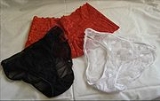
Undergarment
Encyclopedia


Clothing
Clothing refers to any covering for the human body that is worn. The wearing of clothing is exclusively a human characteristic and is a feature of nearly all human societies...
worn under other clothes, often next to the skin. They keep outer garments from being soiled by bodily secretions and discharges, shape the body, and provide support for parts of it. In cold weather, long underwear
Long underwear
Long underwear, also called long johns, Granny pantys, or thermal underwear, is a style of two-piece underwear with long legs and long sleeves that is normally worn during cold weather. It offers an advantage over the one-piece union suit in that the wearer can choose to wear either the top,...
is sometimes worn to provide additional warmth. Some undergarments are intended for erotic
Eroticism
Eroticism is generally understood to refer to a state of sexual arousal or anticipation of such – an insistent sexual impulse, desire, or pattern of thoughts, as well as a philosophical contemplation concerning the aesthetics of sexual desire, sensuality and romantic love...
effect. Special types of undergarments have religious
Religion
Religion is a collection of cultural systems, belief systems, and worldviews that establishes symbols that relate humanity to spirituality and, sometimes, to moral values. Many religions have narratives, symbols, traditions and sacred histories that are intended to give meaning to life or to...
significance. Some items of clothing are designed as underwear, while others, such as T-shirt
T-shirt
A T-shirt is a style of shirt. A T-shirt is buttonless and collarless, with short sleeves and frequently a round neck line....
s and certain types of shorts
Shorts
Shorts are a bifurcated garment worn by both men and women over their pelvic area, circling the waist, and covering the upper part of the legs, sometimes extending down to or even below the knee, but not covering the entire length of the leg. They are called "shorts" because they are a shortened...
, are appropriate both as undergarments and as outer clothing. If made of suitable material, some undergarments can serve as nightwear
Nightwear
Nightwear, also called "sleepwear", "sleeping suit", "nightclothes", or "nightdress", is clothing designed to be worn while sleeping. The style of nightwear worn may vary with the seasons, with eg. warmer styles being worn in colder conditions...
or swimsuit
Swimsuit
A swimsuit, bathing suit, or swimming costume is an item of clothing designed to be worn by men, women or children while they are engaging in a water-based activity or water sports, such as swimming, water polo, diving, surfing, water skiing, or during activities in the sun, such as sun bathing.A...
s.
Undergarments commonly worn by women today include brassiere
Brassiere
A brassiere is an undergarment that covers, supports, and elevates the breasts. Since the late 19th century, it has replaced the corset as the most widely accepted method for supporting breasts....
s and knickers (known in North America as panties
Panties
Panties are a form of underwear, usually light and snug-fitting, designed to be worn by women or girls in the area directly below the waist. Typical components include an elastic waistband, a crotch panel to cover the genital area , and a pair of leg openings which, like the waistband, are often...
), while men often wear briefs
Briefs
Briefs are a type of short, tight underwear and swimwear, as opposed to styles where the material extends down the legs.In the case of men's underwear, briefs, unlike boxer shorts, hold the wearer's genitals in a relatively fixed position, which make briefs a popular underwear choice for men who...
, boxer briefs
Boxer briefs
Boxer briefs are a type of men's undergarment which are long in the leg, like boxer shorts but tighter-fitting, like briefs; a hybrid between the two main types of male underwear in Australia, Canada, United Kingdom, and the United States. Depending on the manufacturer, boxer briefs may also be...
or boxer shorts
Boxer shorts
Boxer shorts are a type of undergarment worn by men. The term has been used in English since 1944 for all-around-elastic shorts, so named after the shorts worn by boxers, for whom unhindered leg movement is very important.Reasons for a preference for boxers can be attributed to their variety of...
. Items commonly worn by both sexes include T-shirts, sleeveless shirts (also called singlets or tank tops), bikini underwear, thongs
Thong (clothing)
The thong is a garment generally worn as either underwear or as a swimsuit in many industrialized societies around the world. It may also be worn for traditional ceremonies or competitions such as sumo wrestling...
, and G-string
G-string
A G-string is a type of thong underwear or swimsuit, a narrow piece of cloth, leather, or plastic, that covers or holds the genitals, passes between the buttocks, and is attached to a band around the hips, worn as swimwear or underwear by women and men...
s.
Terminology
There are several other terms for undergarments. Underclothes, underclothing and underwear are formal terms, while undergarments may be more casually called, in Australia, Reg Grundys (rhyming slang for undies) and Reginalds, and, in the United KingdomUnited Kingdom
The United Kingdom of Great Britain and Northern IrelandIn the United Kingdom and Dependencies, other languages have been officially recognised as legitimate autochthonous languages under the European Charter for Regional or Minority Languages...
, smalls (from the earlier smallclothes) and (historically) unmentionables. In the United States, women's underwear may be known as delicates due to the recommended washing machine cycle.
Women's undergarments collectively are called lingerie
Lingerie
Lingerie are fashionable and possibly alluring undergarments.Lingerie usually incorporates one or more flexible, stretchy materials like Lycra, nylon , polyester, satin, lace, silk and sheer fabric which are not typically used in more functional, basic cotton undergarments.The term in the French...
. They also are called intimate clothing and intimates.
An undershirt
Undershirt
A vest, undershirt, tank top, , singlet or a wife beater is an article of underwear worn underneath a dress shirt intended to protect them from body sweat and odors. It can have short sleeves or be sleeveless. The term most commonly refers to upper-body wear worn by males.It also makes dress...
(vest in the United Kingdom) is a piece of underwear covering the torso
Torso
Trunk or torso is an anatomical term for the central part of the many animal bodies from which extend the neck and limbs. The trunk includes the thorax and abdomen.-Major organs:...
, while underpants (often pants in the United Kingdom), drawers, and shorts cover the genitals
Sex organ
A sex organ, or primary sexual characteristic, as narrowly defined, is any of the anatomical parts of the body which are involved in sexual reproduction and constitute the reproductive system in a complex organism; flowers are the reproductive organs of flowering plants, cones are the reproductive...
and buttocks. Terms for specific undergarments are shown in the table below.
Not wearing underwear under outer clothing is known in American slang as freeballing for men or freebuffing for women, or as going commando
Going commando
Going commando is the practice of not wearing underwear under one's outer clothing. The term is theorized to be related to the much earlier term "going regimental", which refers to wearing the kilt military style, that is, without underwear...
for for either sex.
Function
Underwear is worn for a variety of reasons. They keep outer garments from being soiled by perspiration, urineUrine
Urine is a typically sterile liquid by-product of the body that is secreted by the kidneys through a process called urination and excreted through the urethra. Cellular metabolism generates numerous by-products, many rich in nitrogen, that require elimination from the bloodstream...
, semen
Semen
Semen is an organic fluid, also known as seminal fluid, that may contain spermatozoa. It is secreted by the gonads and other sexual organs of male or hermaphroditic animals and can fertilize female ova...
, menstrual blood and feces
Feces
Feces, faeces, or fæces is a waste product from an animal's digestive tract expelled through the anus or cloaca during defecation.-Etymology:...
. Women's brassiere
Brassiere
A brassiere is an undergarment that covers, supports, and elevates the breasts. Since the late 19th century, it has replaced the corset as the most widely accepted method for supporting breasts....
s provide support for the breasts, and men's briefs
Briefs
Briefs are a type of short, tight underwear and swimwear, as opposed to styles where the material extends down the legs.In the case of men's underwear, briefs, unlike boxer shorts, hold the wearer's genitals in a relatively fixed position, which make briefs a popular underwear choice for men who...
serve the same function for the male genitalia
Male reproductive system (human)
The human male reproductive system consists of a number of sex organs that are a part of the human reproductive process...
. A corset
Corset
A corset is a garment worn to hold and shape the torso into a desired shape for aesthetic or medical purposes...
may be worn as a foundation garment
Foundation garment
A foundation garment is an undergarment designed to temporarily alter the wearer's body shape, to achieve a more fashionable figure...
to alter a woman's body shape
Female body shape
Female body shape or figure is the cumulative product of a woman's skeletal structure and the quantity and distribution of muscle and fat on the body. There are, and have been, wide differences on what should be considered an ideal or preferred body shape, both for attractiveness and for health...
. For additional support and protection when playing sports, men often wear more tightly fitting underwear, including jockstrap
Jockstrap
A jockstrap is an undergarment designed for supporting the male genitalia during sports or other vigorous physical activity...
s and trunks
Boxer briefs
Boxer briefs are a type of men's undergarment which are long in the leg, like boxer shorts but tighter-fitting, like briefs; a hybrid between the two main types of male underwear in Australia, Canada, United Kingdom, and the United States. Depending on the manufacturer, boxer briefs may also be...
. Women may wear sports bra
Sports bra
A sports bra is a bra that provides additional support to female breasts during physical exercise. Sturdier than typical bras, they minimize breast movement, alleviate discomfort, and reduce potential damage to chest ligaments. Many women wear sports bras to reduce pain, and physical discomfort...
s which provide greater support, thus increasing comfort and reducing the chance of damage to the ligament
Ligament
In anatomy, the term ligament is used to denote any of three types of structures. Most commonly, it refers to fibrous tissue that connects bones to other bones and is also known as articular ligament, articular larua, fibrous ligament, or true ligament.Ligament can also refer to:* Peritoneal...
s of the chest during high-impact exercises such as jogging.
In cold climates, underwear may constitute an additional layer of clothing helping to keep the wearer warm. Underwear may also be used to preserve the wearer's modesty
Modesty
Standards of modesty are aspects of the culture of a country or people, at a given point in time, and is a measure against which an individual in society may be judged....
– for instance, some women wear camisole
Camisole
A camisole is a sleeveless undergarment for women, normally extending to the waist. The camisole is usually made of satin, nylon, or cotton.- Historical definition :...
s and slips
Slip (clothing)
Slip is a woman's undergarment worn beneath a dress or skirt to help it hang smoothly and to prevent chafing of the skin from coarse fabrics such as wool...
(petticoat
Petticoat
A petticoat or underskirt is an article of clothing for women; specifically an undergarment to be worn under a skirt or a dress. The petticoat is a separate garment hanging from the waist ....
s) under clothes that are sheer
Sheer (textile)
Sheer fabric is fabric which is made using thin thread and/or low density of knit and which results in a semi-transparent and flimsy cloth. Some fabrics become transparent when wet....
. Conversely, underwear can also be worn for erotic
Eroticism
Eroticism is generally understood to refer to a state of sexual arousal or anticipation of such – an insistent sexual impulse, desire, or pattern of thoughts, as well as a philosophical contemplation concerning the aesthetics of sexual desire, sensuality and romantic love...
effect. It is possible to buy underwear made specifically for sexual titillation, such as edible underwear
Edible underwear
Edible underwear is a candy product which is made into a form and can function as underwear but which is edible.The product was invented by David Sanderson and Lee Brady in 1975 when they formed a company Cosmorotics, Inc. to manufacture and market the product under the name “candypants, the...
and crotch
Crotch
The term crotch may be used to describe the region of an object where it splits into two or more limbs. This can include trees, animals, buildings, in wiring diagrams, etc....
less panties
Panties
Panties are a form of underwear, usually light and snug-fitting, designed to be worn by women or girls in the area directly below the waist. Typical components include an elastic waistband, a crotch panel to cover the genital area , and a pair of leg openings which, like the waistband, are often...
.
Some items of clothing are designed as underwear, while others such as T-shirt
T-shirt
A T-shirt is a style of shirt. A T-shirt is buttonless and collarless, with short sleeves and frequently a round neck line....
s and certain types of shorts
Shorts
Shorts are a bifurcated garment worn by both men and women over their pelvic area, circling the waist, and covering the upper part of the legs, sometimes extending down to or even below the knee, but not covering the entire length of the leg. They are called "shorts" because they are a shortened...
are suitable both as underwear and as outer clothing. The suitability of underwear as outer clothing is, apart from the indoor or outdoor climate, largely dependent on societal norms, fashion
Fashion
Fashion, a general term for a currently popular style or practice, especially in clothing, foot wear, or accessories. Fashion references to anything that is the current trend in look and dress up of a person...
and the requirements of the law. If made of suitable material, some underwear can serve as nightwear
Nightwear
Nightwear, also called "sleepwear", "sleeping suit", "nightclothes", or "nightdress", is clothing designed to be worn while sleeping. The style of nightwear worn may vary with the seasons, with eg. warmer styles being worn in colder conditions...
or swimsuit
Swimsuit
A swimsuit, bathing suit, or swimming costume is an item of clothing designed to be worn by men, women or children while they are engaging in a water-based activity or water sports, such as swimming, water polo, diving, surfing, water skiing, or during activities in the sun, such as sun bathing.A...
s.
Religious functions
Undergarments can also have religiousReligion
Religion is a collection of cultural systems, belief systems, and worldviews that establishes symbols that relate humanity to spirituality and, sometimes, to moral values. Many religions have narratives, symbols, traditions and sacred histories that are intended to give meaning to life or to...
significance:
- Judaism. Male Orthodox JewsOrthodox JudaismOrthodox Judaism , is the approach to Judaism which adheres to the traditional interpretation and application of the laws and ethics of the Torah as legislated in the Talmudic texts by the Sanhedrin and subsequently developed and applied by the later authorities known as the Gaonim, Rishonim, and...
wear, draped over their shoulders, a prayer shawlShawlA shawl is a simple item of clothing, loosely worn over the shoulders, upper body and arms, and sometimes also over the head. It is usually a rectangular or square piece of cloth, that is often folded to make a triangle but can also be triangular in shape...
known as a tallit katan, with tzitzitTzitzitThe Hebrew noun tzitzit is the name for specially knotted ritual fringes worn by observant Jews. Tzitzit are attached to the four corners of the tallit and tallit katan.-Etymology:The word may derive from the semitic root N-TZ-H...
(fringes) attached to each of its four corners. To conform with societal dress codes, the tallit katan is often worn beneath the shirt but – since it must not come into contact with the skin – above an undershirt. - Mormonism. Following their endowmentEndowment (Mormonism)In Mormonism, the endowment is an ordinance designed to prepare participants to become kings, queens, priests, and priestesses in the afterlife. As part of the ceremony, participants take part in a scripted reenactment of the Biblical creation and fall of Adam and Eve...
in a templeTemple (Mormonism)In the Latter Day Saint movement, a temple is a building dedicated to be a house of God and is reserved for special forms of worship. A temple differs from a church meetinghouse, which is used for weekly worship services. Temples have been a significant part of the Latter Day Saint movement since...
, MormonsMormonismMormonism is the religion practiced by Mormons, and is the predominant religious tradition of the Latter Day Saint movement. This movement was founded by Joseph Smith, Jr. beginning in the 1820s as a form of Christian primitivism. During the 1830s and 1840s, Mormonism gradually distinguished itself...
wear special temple garmentTemple garmentA Temple garment is a type of underwear worn by members of some denominations of the Latter Day Saint movement, after they have taken part in the Endowment ceremony. Garments are worn both day and night and are required for any previously endowed adult to enter a church temple...
s which help them to remember the teachings of the temple. - Sikhism. One of the five articles of faith (panj kakaar) worn by SikhSikhismSikhism is a monotheistic religion founded during the 15th century in the Punjab region, by Guru Nanak Dev and continued to progress with ten successive Sikh Gurus . It is the fifth-largest organized religion in the world and one of the fastest-growing...
men is a certain style of underpants similar to boxer shortsBoxer shortsBoxer shorts are a type of undergarment worn by men. The term has been used in English since 1944 for all-around-elastic shorts, so named after the shorts worn by boxers, for whom unhindered leg movement is very important.Reasons for a preference for boxers can be attributed to their variety of...
and known as the kacchaKacchaKacchera or Kaccha are specially designed short, shalwar-like) loose undergarments with a tie-knot worn by baptized Sikhs. It is one of the five Sikh articles of faith called the Five Ks , and was given as a "gift of love" by Gobind Singh at the Baisakhi Amrit Sanskar in 1699...
.
Not wearing undergarments
Some people choose not to wear any underwear. People may choose not to wear underwear for reasons of comfort, to enable their outer garments (particularly those which are form-fitting) to look more flattering, to avoid creating a panty linePanty line
A visible panty line is the situation when the outline of a person's underwear is visible through the clothing. The underpants may be seen as a ridge or depression in the clothes, or as a result of the clothing material being sufficiently transparent....
or because they find it sexually exciting, or because they do not see any need for them.
Certain types of clothes, such as cycling shorts
Cycling shorts
Cycling shorts are short, skin-tight legwear designed to improve comfort and efficiency while cycling...
and kilt
Kilt
The kilt is a knee-length garment with pleats at the rear, originating in the traditional dress of men and boys in the Scottish Highlands of the 16th century. Since the 19th century it has become associated with the wider culture of Scotland in general, or with Celtic heritage even more broadly...
s, are designed to be worn or are traditionally worn without underwear. This also applies for most clothes worn as nightwear
Nightwear
Nightwear, also called "sleepwear", "sleeping suit", "nightclothes", or "nightdress", is clothing designed to be worn while sleeping. The style of nightwear worn may vary with the seasons, with eg. warmer styles being worn in colder conditions...
and as swimwear.
Types and styles
Common contemporary types and styles of undergarments are listed in the table below.| Type | Other names | Information | Varieties | |
|---|---|---|---|---|
| Worn by both sexes | ||||
| Whole body | ||||
| Long underwear Long underwear Long underwear, also called long johns, Granny pantys, or thermal underwear, is a style of two-piece underwear with long legs and long sleeves that is normally worn during cold weather. It offers an advantage over the one-piece union suit in that the wearer can choose to wear either the top,...  |
Long johns, long handles | A two-piece undergarment worn during cold weather consisting of a shirt with sleeves extending to the wrists and trousers with pant legs reaching down to the ankles. |
|
|
| Upper body | ||||
Sleeveless shirt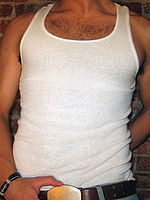 |
Tank top, wife beater, singlet | A sleeveless garment similar to a T-shirt. |
|
|
| T-shirt T-shirt A T-shirt is a style of shirt. A T-shirt is buttonless and collarless, with short sleeves and frequently a round neck line....  |
Tee | A garment covering a person's torso which is usually without buttons, pockets or a collar, and has long or (mostly) short sleeves. It is worn by pulling it over the head. |
|
|
| Lower body | ||||
Tanga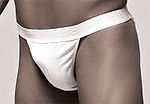 |
A type of thong which has no material around the sides other than the waistband. | |||
| Worn by women | ||||
| Upper body | ||||
| Brassiere Brassiere A brassiere is an undergarment that covers, supports, and elevates the breasts. Since the late 19th century, it has replaced the corset as the most widely accepted method for supporting breasts....  |
Bra | Usually consists of two cups for the breasts, a centre panel (gore), a band running around the torso under the bust, and a shoulder strap for each side. |
Sports bra A sports bra is a bra that provides additional support to female breasts during physical exercise. Sturdier than typical bras, they minimize breast movement, alleviate discomfort, and reduce potential damage to chest ligaments. Many women wear sports bras to reduce pain, and physical discomfort... |
|
| Lower body | ||||
| Boy shorts Boyshorts Boy shorts, also known as boy short panties, boys' cut, booty shorts, shorties, tap panties or boyleg briefs are a kind of women's underwear that goes all the way down the hips, named for their similarity in looks to men's knit boxer shorts, which themselves are a variation on traditional boxer... |
Booty shorts, boyleg briefs, boy short panties, boys' cut shorts, boyshorts, shorties | A type of panties with sides that extend lower down the hips, similar to men's briefs. | ||
Knickers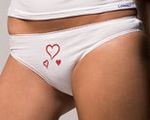 |
USA: Panties Panties Panties are a form of underwear, usually light and snug-fitting, designed to be worn by women or girls in the area directly below the waist. Typical components include an elastic waistband, a crotch panel to cover the genital area , and a pair of leg openings which, like the waistband, are often... |
These usually have an elastic waistband, a crotch to cover the genital area which is usually lined with absorbent material such as cotton, and a pair of leg openings which are often also elasticized. They either have very short or no leg sections. |
Spandex Spandex or elastane is a synthetic fibre known for its exceptional elasticity. It is strong, but less durable than natural Latex, its major non-synthetic competitor. It is a polyurethane-polyurea copolymer that was co-invented in 1959 by chemists C. L. Sandquist and Joseph Shivers at DuPont's... and extending above the waist, these are designed to provide support and create a slimmer appearance. |
|
Bikini underwear |
Usually worn with the waistband lower than the wearer's waist, and often at the hips, with the leg bands ending at the groin Groin In human anatomy, the groin areas are the two creases at the junction of the torso with the legs, on either side of the pubic area. This is also known as the medial compartment of the thigh. A pulled groin muscle usually refers to a painful injury sustained by straining the hip adductor muscles... . Men's bikini briefs normally have no fly Fly (clothing) A fly on clothing is a covering over an opening join concealing the mechanism, such as a zip, velcro or buttons, used to join the opening. The term is most frequently applied to a short opening over the groin in trousers, shorts and other garments, which makes them easier to put on or take off and... . |
Groin In human anatomy, the groin areas are the two creases at the junction of the torso with the legs, on either side of the pubic area. This is also known as the medial compartment of the thigh. A pulled groin muscle usually refers to a painful injury sustained by straining the hip adductor muscles... but not at the sides, with a thin "string" around the waist connecting the pieces. |
||
| G-string G-string A G-string is a type of thong underwear or swimsuit, a narrow piece of cloth, leather, or plastic, that covers or holds the genitals, passes between the buttocks, and is attached to a band around the hips, worn as swimwear or underwear by women and men... |
Gee-string, gee string | A type of thong consisting of a narrow piece of material that covers or holds the genitals, passes between the buttocks, and is attached to a band around the hips. | ||
| Thong Thong (clothing) The thong is a garment generally worn as either underwear or as a swimsuit in many industrialized societies around the world. It may also be worn for traditional ceremonies or competitions such as sumo wrestling...  |
Has a narrow strip of material along the centre of the garment's rear which sits between the wearer's buttocks and connects the front or pouch to the waistband behind the wearer. Thongs are sometimes worn to reduce "panty line Panty line A visible panty line is the situation when the outline of a person's underwear is visible through the clothing. The underpants may be seen as a ridge or depression in the clothes, or as a result of the clothing material being sufficiently transparent.... s" when wearing tightly fitting trousers Trousers Trousers are an item of clothing worn on the lower part of the body from the waist to the ankles, covering both legs separately... . |
|||
| Worn by men | ||||
| Lower body | ||||
| Boxer briefs Boxer briefs Boxer briefs are a type of men's undergarment which are long in the leg, like boxer shorts but tighter-fitting, like briefs; a hybrid between the two main types of male underwear in Australia, Canada, United Kingdom, and the United States. Depending on the manufacturer, boxer briefs may also be... 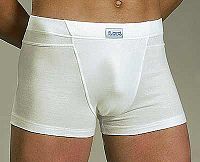 |
Trunks | These are similar in style to boxer shorts, but are generally shorter and form-fitting like briefs. |
|
|
| Boxer shorts Boxer shorts Boxer shorts are a type of undergarment worn by men. The term has been used in English since 1944 for all-around-elastic shorts, so named after the shorts worn by boxers, for whom unhindered leg movement is very important.Reasons for a preference for boxers can be attributed to their variety of... 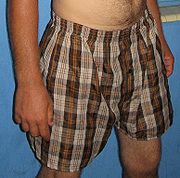 |
Boxers | These have an elasticized waistband that is at or near the wearer's waist, while the leg sections are fairly loose and extend to the mid-thigh. There is usually a fly, either with or without button Button In modern clothing and fashion design, a button is a small fastener, most commonly made of plastic, but also frequently of seashell, which secures two pieces of fabric together. In archaeology, a button can be a significant artifact. In the applied arts and in craft, a button can be an example of... s. The waistbands of boxer shorts are usually wider than those of briefs, and often bear the brand name Brand The American Marketing Association defines a brand as a "Name, term, design, symbol, or any other feature that identifies one seller's good or service as distinct from those of other sellers."... of the manufacturer.
|
|
|
| Briefs Briefs Briefs are a type of short, tight underwear and swimwear, as opposed to styles where the material extends down the legs.In the case of men's underwear, briefs, unlike boxer shorts, hold the wearer's genitals in a relatively fixed position, which make briefs a popular underwear choice for men who... 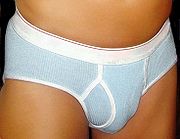 |
UK: Slip, Y-fronts US: Jockey shorts, tightie-whities |
These have an elasticized waistband at or near the wearer's waist, and leg sections that end at or near the groin Groin In human anatomy, the groin areas are the two creases at the junction of the torso with the legs, on either side of the pubic area. This is also known as the medial compartment of the thigh. A pulled groin muscle usually refers to a painful injury sustained by straining the hip adductor muscles... . |
|
|
| Jockstrap Jockstrap A jockstrap is an undergarment designed for supporting the male genitalia during sports or other vigorous physical activity...  |
Athletic supporter, jock, strap, supporter | Consists of an elastic waistband with a support pouch for the genitalia and two elastic straps affixed to the base of the pouch and to the left and right sides of the waistband at the hip. In some varieties, the pouch may be fitted with a pocket to hold an impact-resistant cup to protect the genitals from injury. |
|
|
| Religious Under Clothing | ||||
| Whole body | ||||
| Temple Garment Temple garment A Temple garment is a type of underwear worn by members of some denominations of the Latter Day Saint movement, after they have taken part in the Endowment ceremony. Garments are worn both day and night and are required for any previously endowed adult to enter a church temple... s 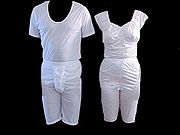 |
||||
| Upper body | ||||
| Tallit katan | ||||
| Lower body | ||||
| Kachchhera | ||||
Exposed underwear
Underwear is sometimes partly exposed for fashion reasons or to titillate. A woman may, for instance, allow the top of her brassiere to be visible from under her collarCollar (clothing)
In clothing, a collar is the part of a shirt, dress, coat or blouse that fastens around or frames the neck. Among clothing construction professionals, a collar is differentiated from other necklines such as revers and lapels, by being made from a separate piece of fabric, rather than a folded or...
, or wear a see-through blouse
Blouse
A blouse is a loose-fitting upper garment that was formerly worn by workmen, peasants, artists, women and children. It is typically gathered at the waist so that it hangs loosely over the wearer's body. Today, the word most commonly refers to a woman's shirt but can also refer to a man's shirt if...
over it. Some men wear T-shirts underneath partly or fully unbuttoned shirt
Shirt
A shirt is a cloth garment for the upper body. Originally an undergarment worn exclusively by men, it has become, in American English, a catch-all term for almost any garment other than outerwear such as sweaters, coats, jackets, or undergarments such as bras, vests or base layers...
s.
A common style among young men is to allow their trousers to sag
Sagging (fashion)
Sagging is a manner of wearing trousers below the waist, hanging below the waist area and therefore revealing much of the underwear. Sagging is predominantly a male fashion...
below their waists, thus revealing the waistband or a greater portion of their boxer shorts, briefs, or boxer briefs. A woman wearing low-rise trousers which expose the upper rear portion of her thong underwear is said to display a "whale tail
Whale tail
Whale tail is the Y-shaped waistband of a thong or g-string when visible above the waistline of low-rise jeans, shorts, or a skirt that resembles a whale's tail. Intentionally or unintentionally, a whale tail is exposed above the trousers mostly when sitting or bending, or even while standing...
".
Ancient history
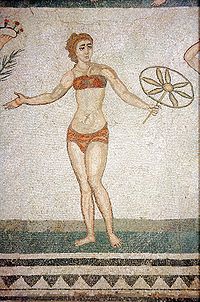
Loincloth
A loincloth is a one-piece male garment, sometimes kept in place by a belt, which covers the genitals and, at least partially, the buttocks.-History and types:Loincloths are being and have been worn:*in societies where no other clothing is needed or wanted...
is the simplest form of underwear; it was probably the first undergarment worn by human beings. In warmer climates the loincloth was often the only clothing worn (effectively making it an outer garment rather than an undergarment), as was doubtless its origin, but in colder regions the loincloth often formed the basis of a person's clothing and was covered by other garments. In most ancient civilizations, this was the only undergarment available.
A loincloth may take three major forms. The first, and simplest, is simply a long strip of material which is passed between the legs and then around the waist. Archaeologists have found the remains of such loincloths made of leather
Leather
Leather is a durable and flexible material created via the tanning of putrescible animal rawhide and skin, primarily cattlehide. It can be produced through different manufacturing processes, ranging from cottage industry to heavy industry.-Forms:...
dating back 7,000 years. The ancient Hawaii
Hawaii
Hawaii is the newest of the 50 U.S. states , and is the only U.S. state made up entirely of islands. It is the northernmost island group in Polynesia, occupying most of an archipelago in the central Pacific Ocean, southwest of the continental United States, southeast of Japan, and northeast of...
an malo was of this form, as are several styles of the Japanese fundoshi
Fundoshi
is the traditional Japanese undergarment for adult males, made from a length of cotton. Before World War II, the fundoshi was the main form of underwear for Japanese adult males...
. Another form is usually called a cache-sexe
Cache-sexe
A cache-sexe is an item, often a small garment, that covers its user's genitals. The most common style, seen in Western G-strings and Japanese Fundoshis, has a triangle of material attached at the corners to straps or strings around the waist and between the legs, that fasten the triangle over the...
: a triangle of cloth is provided with strings or loops, which are used to fasten the triangle between the legs and over the genitals. Egypt
Egypt
Egypt , officially the Arab Republic of Egypt, Arabic: , is a country mainly in North Africa, with the Sinai Peninsula forming a land bridge in Southwest Asia. Egypt is thus a transcontinental country, and a major power in Africa, the Mediterranean Basin, the Middle East and the Muslim world...
ian king Tutankhamun
Tutankhamun
Tutankhamun , Egyptian , ; approx. 1341 BC – 1323 BC) was an Egyptian pharaoh of the 18th dynasty , during the period of Egyptian history known as the New Kingdom...
(1341 BC – 1323 BC) was found buried with numerous linen
Linen
Linen is a textile made from the fibers of the flax plant, Linum usitatissimum. Linen is labor-intensive to manufacture, but when it is made into garments, it is valued for its exceptional coolness and freshness in hot weather....
loincloths of this style. An alternate form is more skirt
Skirt
A skirt is a tube- or cone-shaped garment that hangs from the waist and covers all or part of the legs.In the western world, skirts are usually considered women's clothing. However, there are exceptions...
-like: a cloth is wrapped around the hips several times and then fastened with a girdle
Girdle
A girdle is a garment that encircles the lower torso, perhaps extending below the hips, and worn often for support. The word girdle originally meant a belt. In modern English, the term girdle is most commonly used for a form of women's foundation wear that replaced the corset in popularity...
.
Men are said to have worn loincloths in ancient Greece
Ancient Greece
Ancient Greece is a civilization belonging to a period of Greek history that lasted from the Archaic period of the 8th to 6th centuries BC to the end of antiquity. Immediately following this period was the beginning of the Early Middle Ages and the Byzantine era. Included in Ancient Greece is the...
and Rome
Ancient Rome
Ancient Rome was a thriving civilization that grew on the Italian Peninsula as early as the 8th century BC. Located along the Mediterranean Sea and centered on the city of Rome, it expanded to one of the largest empires in the ancient world....
, though it is unclear whether Greek women wore undergarments. There is some speculation that only slaves wore loincloths and that citizens did not wear undergarments beneath their chiton
Chiton (costume)
A chiton was a form of clothing worn by men and women in Ancient Greece, from the Archaic period to the Hellenistic period ....
s. Mosaic
Mosaic
Mosaic is the art of creating images with an assemblage of small pieces of colored glass, stone, or other materials. It may be a technique of decorative art, an aspect of interior decoration, or of cultural and spiritual significance as in a cathedral...
s of the Roman period indicate that women (primarily in an athletic context, whilst wearing nothing else) sometimes wore strophiae (breastcloths) or brassiere
Brassiere
A brassiere is an undergarment that covers, supports, and elevates the breasts. Since the late 19th century, it has replaced the corset as the most widely accepted method for supporting breasts....
s made of soft leather, along with subligaculae
Subligaculum
A subligaculum was a kind of undergarment worn by ancient Romans. It could come either in the form of a pair of shorts, or in the form of a simple loincloth wrapped around the lower body. It could be worn both by men and women. In particular, it was part of the dress of gladiators, athletes, and of...
which were either in the form of shorts
Shorts
Shorts are a bifurcated garment worn by both men and women over their pelvic area, circling the waist, and covering the upper part of the legs, sometimes extending down to or even below the knee, but not covering the entire length of the leg. They are called "shorts" because they are a shortened...
or loincloths. Subligaculae were also worn by men.
The fabric used for loincloths may have been wool
Wool
Wool is the textile fiber obtained from sheep and certain other animals, including cashmere from goats, mohair from goats, qiviut from muskoxen, vicuña, alpaca, camel from animals in the camel family, and angora from rabbits....
, linen
Linen
Linen is a textile made from the fibers of the flax plant, Linum usitatissimum. Linen is labor-intensive to manufacture, but when it is made into garments, it is valued for its exceptional coolness and freshness in hot weather....
or a linsey-woolsey
Linsey-woolsey
Linsey-woolsey is a coarse twill or plain-woven fabric woven with a linen warp and a woollen weft. Similar fabrics woven with a cotton warp and woollen weft in Colonial America were also called linsey-woolsey or wincey. The name derives form a combination of linen and woollen...
blend. Only the upper classes could have afforded imported silk
Silk
Silk is a natural protein fiber, some forms of which can be woven into textiles. The best-known type of silk is obtained from the cocoons of the larvae of the mulberry silkworm Bombyx mori reared in captivity...
.
The loincloth continues to be worn by people around the world – it is the traditional form of undergarment in many Asian societies, for example. In various, mainly tropical, cultures, the traditional male dress may still consist of only a single garment below the waist or even none at all, with underwear as optional, including the Far-Eastern
Far East
The Far East is an English term mostly describing East Asia and Southeast Asia, with South Asia sometimes also included for economic and cultural reasons.The term came into use in European geopolitical discourse in the 19th century,...
dhoti
Dhoti
The dhoti or pancha is the traditional men's garment in the in India, Bangladesh and Sri Lanka. A similar garment is worn in some rural areas of Punjab province in Pakistan, but the use is fast declining...
and lungi
Lungi
The Lungi , also known as a sarong , is a traditional garment worn around the waist in India, Pakistan, Bangladesh, Sri Lanka, Burma, Brunei, Indonesia, Malaysia, Singapore, the Horn of Africa and the southern Arabian Peninsula...
, or the Scottish kilt
Kilt
The kilt is a knee-length garment with pleats at the rear, originating in the traditional dress of men and boys in the Scottish Highlands of the 16th century. Since the 19th century it has become associated with the wider culture of Scotland in general, or with Celtic heritage even more broadly...
.
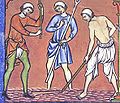
Middle Ages and Renaissance
In the Middle AgesMiddle Ages
The Middle Ages is a periodization of European history from the 5th century to the 15th century. The Middle Ages follows the fall of the Western Roman Empire in 476 and precedes the Early Modern Era. It is the middle period of a three-period division of Western history: Classic, Medieval and Modern...
, western men's underwear became looser fitting. The loincloth was replaced by loose, trouser
Trousers
Trousers are an item of clothing worn on the lower part of the body from the waist to the ankles, covering both legs separately...
-like clothing called braies
Braies (undergarment)
Braies are a type of trouser worn by Celtic and Germanic tribes in antiquity and by Europeans subsequently into the Middle ages. In the later middle ages they were used exclusively as undergarments. Braies generally hung to the knees or mid-calf, resembling what are today called shorts. They...
, which the wearer stepped into and then laced or tied around the waist and legs at about mid-calf. Wealthier men often wore chausses
Chausses
Chausses are armour for the legs, usually made from mail. They could extend to the knee or cover the entire leg. Chausses were the standard type of metal leg armour during most of the European Middle Ages. Chausses offered flexible protection that was effective against slashing weapons...
as well, which only covered the legs.

Renaissance
The Renaissance was a cultural movement that spanned roughly the 14th to the 17th century, beginning in Italy in the Late Middle Ages and later spreading to the rest of Europe. The term is also used more loosely to refer to the historical era, but since the changes of the Renaissance were not...
, braies had become shorter to accommodate longer styles of chausses. Chausses were also giving way to form-fitting hose
Hose (clothing)
Hose are any of various styles of men's clothing for the legs and lower body, worn from the Middle Ages through the 17th century, when the term fell out of use in favor of breeches and stockings. The old plural form of "hose" was hosen...
, which covered the legs and feet. Fifteenth-century hose were often particolored, with each leg in a different-coloured fabric or even more than one colour on a leg. However, many types of braies, chausses and hose were not intended to be covered up by other clothing, so they were not actually underwear in the strict sense.
Braies were usually fitted with a front flap that was buttoned or tied closed. This codpiece
Codpiece
A codpiece is a covering flap or pouch that attaches to the front of the crotch of men's trousers and usually accentuates the genital area. It was held closed by string ties, buttons, or other methods...
allowed men to urinate
Urination
Urination, also known as micturition, voiding, peeing, weeing, pissing, and more rarely, emiction, is the ejection of urine from the urinary bladder through the urethra to the outside of the body. In healthy humans the process of urination is under voluntary control...
without having to remove the braies completely. Codpieces were also worn with hose when very short doublets
Doublet (clothing)
A doublet is a man's snug-fitting buttoned jacket that is fitted and shaped to the man's body which was worn in Western Europe from the Middle Ages through to the mid-17th century. The doublet was hip length or waist length and worn over the shirt or drawers. Until the end of the 15th century the...
– vest
Vest
A vest is a garment covering the upper body. The term has different meanings around the world:Waistcoat :. This is called a waistcoat in the UK and many Commonwealth countries, or a vest in the US and Canada. It is often worn as part of formal attire, or as the third piece of a lounge...
-like garments tied together in the front and worn under other clothing – were in fashion, as early forms of hose were open at the crotch
Crotch
The term crotch may be used to describe the region of an object where it splits into two or more limbs. This can include trees, animals, buildings, in wiring diagrams, etc....
. Henry VIII of England
Henry VIII of England
Henry VIII was King of England from 21 April 1509 until his death. He was Lord, and later King, of Ireland, as well as continuing the nominal claim by the English monarchs to the Kingdom of France...
began padding his codpiece, which caused a spiralling trend of larger and larger codpieces that only ended by the end of the 16th century. It has been speculated that the King may have had the venereal disease syphilis
Syphilis
Syphilis is a sexually transmitted infection caused by the spirochete bacterium Treponema pallidum subspecies pallidum. The primary route of transmission is through sexual contact; however, it may also be transmitted from mother to fetus during pregnancy or at birth, resulting in congenital syphilis...
, and his large codpiece may have included a bandage soaked in medication to relieve its symptoms. Henry VIII also wanted a healthy son and may have thought that projecting himself in this way would portray fertility. Codpieces were sometimes used as a pocket for holding small items.
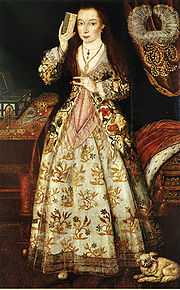
Chemise
The term chemise or shift can refer to the classic smock, or else can refer to certain modern types of women's undergarments and dresses...
in France, or a smock or shift in England. The forerunner of the modern-day shirt
Shirt
A shirt is a cloth garment for the upper body. Originally an undergarment worn exclusively by men, it has become, in American English, a catch-all term for almost any garment other than outerwear such as sweaters, coats, jackets, or undergarments such as bras, vests or base layers...
, the chemise was tucked into a man's braies, under his outer clothing. Women wore a chemise underneath their gown
Gown
A gown is a loose outer garment from knee- to full-length worn by men and women in Europe from the early Middle Ages to the 17th century ; later, gown was applied to any woman's garment consisting of a bodice and attached skirt.A long, loosely-fitted gown called a Banyan was worn by men in the 18th...
s or robe
Robe
A robe is a loose-fitting outer garment. A robe is distinguished from a cape or cloak by the fact that it usually has sleeves. The English word robe derives from Middle English robe , borrowed from Old French robe , itself taken from the Frankish word *rouba , and is related to the word rob...
s, sometimes with petticoat
Petticoat
A petticoat or underskirt is an article of clothing for women; specifically an undergarment to be worn under a skirt or a dress. The petticoat is a separate garment hanging from the waist ....
s over the chemise. Elaborately quilted
Quilting
Quilting is a sewing method done to join two or more layers of material together to make a thicker padded material. A quilter is the name given to someone who works at quilting. Quilting can be done by hand, by sewing machine, or by a specialist longarm quilting system.The process of quilting uses...
petticoats might be displayed by a cut-away dress, in which case they served a skirt rather than an undergarment. During the 16th century, the farthingale
Farthingale
Farthingale is a term applied to any of several structures used under Western European women's clothing in the late 15th and 16th centuries to support the skirts into the desired shape. It originated in Spain.- Spanish farthingale :...
was popular. This was a petticoat stiffened with reed
Phragmites
Phragmites, the Common reed, is a large perennial grass found in wetlands throughout temperate and tropical regions of the world. Phragmites australis is sometimes regarded as the sole species of the genus Phragmites, though some botanists divide Phragmites australis into three or four species...
or willow
Willow
Willows, sallows, and osiers form the genus Salix, around 400 species of deciduous trees and shrubs, found primarily on moist soils in cold and temperate regions of the Northern Hemisphere...
rods so that it stood out from a woman's body like a cone extending from the waist.
Corset
Corset
A corset is a garment worn to hold and shape the torso into a desired shape for aesthetic or medical purposes...
s also began to be worn about this time. At first they were called pairs of bodies, which refers to a stiffened decorative bodice
Bodice
A bodice, historically, is an article of clothing for women, covering the body from the neck to the waist. In modern usage it typically refers to a specific type of upper garment common in Europe during the 16th to the 18th century, or to the upper portion of a modern dress to distinguish it from...
worn on top of another bodice stiffened with buckram
Buckram
Buckram is a stiff cloth, made of cotton, and still occasionally linen, which is used to cover and protect books. Buckram can also be used to stiffen clothes. Modern buckrams have been stiffened by soaking in a substance, usually now pyroxylin, to fill the gaps between the fibres.In the Middle...
, reeds, canes, whalebone
Baleen
Baleen or whalebone is a filter-feeder system inside the mouths of baleen whales. The baleen system works when a whale opens its mouth underwater and then water pours into the whale's mouth. The whale then pushes the water out, and animals such as krill are filtered by the baleen and remain as food...
or other materials. These were not the small-waisted, curved corsets familiar from the Victorian era
Victorian era
The Victorian era of British history was the period of Queen Victoria's reign from 20 June 1837 until her death on 22 January 1901. It was a long period of peace, prosperity, refined sensibilities and national self-confidence...
, but straight-lined corsets that flattened the bust.
There is a myth that Crusaders
Crusades
The Crusades were a series of religious wars, blessed by the Pope and the Catholic Church with the main goal of restoring Christian access to the holy places in and near Jerusalem...
, worried about the fidelity
Fidelity
"Fidelity" is the quality of being faithful or loyal. Its original meaning regarded duty to a lord or a king, in a broader sense than the related concept of fealty. Both derive from the Latin word fidēlis, meaning "faithful or loyal"....
of their wives, forced them to wear chastity belt
Chastity belt
A chastity belt is a locking item of clothing designed to prevent sexual intercourse. They may be used to protect the wearer from rape or temptation. Some devices have been designed with additional features to prevent masturbation...
s. There is no reference, image, or surviving belt to support this story. Most historians of this period are of the view that a chastity belt was worn to prevent sexual assault and that the woman kept the key.
Men's braies and hose were eventually replaced by simple cotton, silk or linen
Linen
Linen is a textile made from the fibers of the flax plant, Linum usitatissimum. Linen is labor-intensive to manufacture, but when it is made into garments, it is valued for its exceptional coolness and freshness in hot weather....
drawers, which were usually knee-length trousers with a button flap in the front.
Enlightenment and Industrial Age

Spinning jenny
The spinning jenny is a multi-spool spinning frame. It was invented c. 1764 by James Hargreaves in Stanhill, Oswaldtwistle, Lancashire in England. The device reduced the amount of work needed to produce yarn, with a worker able to work eight or more spools at once. This grew to 120 as technology...
machines and the cotton gin
Cotton gin
A cotton gin is a machine that quickly and easily separates cotton fibers from their seeds, a job formerly performed painstakingly by hand...
in the second half of the 18th century made cotton fabrics widely available. This allowed factories to mass-produce
Mass production
Mass production is the production of large amounts of standardized products, including and especially on assembly lines...
underwear, and for the first time, people began buying undergarments in stores rather than making them at home.
Women's stays of the 18th century were laced behind and drew the shoulders back to form a high, round bosom and erect posture. Coloured stays were popular. With the relaxed country styles of the end of the century, stays became shorter and were unboned
Bone (corsetry)
In corsetry, a bone is one of the rigid parts of a corset that forms its frame and gives it rigidity.-Purpose, history and materials:The purpose of the boning in a corset varies slightly from era to era....
or only lightly boned, and were now called corset
Corset
A corset is a garment worn to hold and shape the torso into a desired shape for aesthetic or medical purposes...
s. Undue binding of a corset sometimes led to a woman needing to retire to the fainting room
Fainting room
A fainting room was a room, used during the Victorian era, where women could go to rest when feeling faint. Fainting rooms often included fainting couches where women would faint or recline without fearing bodily harm...
. As tight waists became fashionable in the 1820s, the corset was again boned and laced to form the figure. By the 1860s, a tiny ("wasp") waist came to be seen as a symbol of beauty, and the corsets were stiffened with whalebone or steel to accomplish this. By the 1880s, the dress reform
Victorian dress reform
During the middle and late Victorian period, various reformers proposed, designed, and wore clothing supposedly more rational and comfortable than the fashions of the time. This was known as the dress reform or rational dress movement...
movement was campaigning against the pain and damage to internal organs and bones caused by tight lacing
Tightlacing
Tightlacing is the practice of wearing a tightly-laced corset to achieve extreme modifications to the figure and posture and experience the sensations of a very tight corset. Those who practice tightlacing are called tightlacers...
. Inez Gaches-Sarraute invented the "health corset", with a straight-fronted bust made to help support the wearer's muscles.
The corset was usually worn over a thin shirt-like shift of cotton or muslin
Muslin
Muslin |sewing patterns]], such as for clothing, curtains, or upholstery. Because air moves easily through muslin, muslin clothing is suitable for hot, dry climates.- Etymology and history :...
. In the latter half of the 19th century, as skirt
Skirt
A skirt is a tube- or cone-shaped garment that hangs from the waist and covers all or part of the legs.In the western world, skirts are usually considered women's clothing. However, there are exceptions...
styles became shorter, long drawers called pantalettes
Pantalettes
Pantalettes are undergarments covering the legs worn by women, girls, and very young boys in the early- to mid-nineteenth century....
or pantaloons often accompanied the shift to keep the legs out of sight.

Crinoline
Crinoline was originally a stiff fabric with a weft of horse-hair and a warp of cotton or linen thread. The fabric first appeared around 1830, but by 1850 the word had come to mean a stiffened petticoat or rigid skirt-shaped structure of steel designed to support the skirts of a woman’s dress into...
s and later hoop skirts allowed ever wider skirts to be worn. The bustle
Bustle
A bustle is a type of framework used to expand the fullness or support the drapery of the back of a woman's dress, occurring predominantly in the mid-to-late 19th century. Bustles were worn under the skirt in the back, just below the waist, to keep the skirt from dragging. Heavy fabric tended to...
, a frame or pad worn over the buttocks to enhance their shape, had been used off and on by women for two centuries, but reached the height of its popularity in the later 1880s, and went out of fashion for good in the 1890s.
Women dressed in crinolines generally wore drawers under them for modesty and warmth.
Another common undergarment of the late-19th century for men, women and children was the union suit
Union suit
A union suit is a type of one-piece long underwear. Created in Utica, New York, United States, it originated as women's wear during the 19th-century United States clothing reform efforts, as an alternative to constricting garments, and soon gained popularity among men as well...
. Invented in Utica, New York
Utica, New York
Utica is a city in and the county seat of Oneida County, New York, United States. The population was 62,235 at the 2010 census, an increase of 2.6% from the 2000 census....
, and patented in 1868, this was a one-piece front-buttoning garment usually made of knitted material with sleeves extending to the wrists and legs down to the ankles. It had a buttoned flap (known colloquially as the "access hatch", "drop seat" or "fireman's flap") in the back to ease visits to the toilet. The union suit was the precursor of long johns
Long underwear
Long underwear, also called long johns, Granny pantys, or thermal underwear, is a style of two-piece underwear with long legs and long sleeves that is normally worn during cold weather. It offers an advantage over the one-piece union suit in that the wearer can choose to wear either the top,...
, a two-piece garment consisting of a long-sleeved top and long pants possibly named after American boxer John L. Sullivan
John L. Sullivan
John Lawrence Sullivan , also known as the Boston Strong Boy, was recognized as the first heavyweight champion of gloved boxing from February 7, 1881 to 1892, and is generally recognized as the last heavyweight champion of bare-knuckle boxing under the London Prize Ring rules...
who wore a similar garment in the ring.
The jockstrap
Jockstrap
A jockstrap is an undergarment designed for supporting the male genitalia during sports or other vigorous physical activity...
was invented in 1874 by C.F. Bennett of a Chicago
Chicago
Chicago is the largest city in the US state of Illinois. With nearly 2.7 million residents, it is the most populous city in the Midwestern United States and the third most populous in the US, after New York City and Los Angeles...
sporting goods company, Sharp & Smith, to provide comfort and support for bicycle jockeys riding the cobblestone
Cobblestone
Cobblestones are stones that were frequently used in the pavement of early streets. "Cobblestone" is derived from the very old English word "cob", which had a wide range of meanings, one of which was "rounded lump" with overtones of large size...
streets of Boston, Massachusetts. In 1897 Bennett's newly formed Bike Web Company patented and began mass-producing the Bike Jockey Strap.
1900s to 1920s
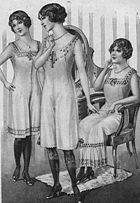

Hanes
Hanes and Hanes Her Way are brands of apparel currently owned by the HanesBrands, Inc Corporation...
company emerged from this boom and quickly established itself as a top manufacturer of union suits, which were common until the 1930s. Textile
Textile
A textile or cloth is a flexible woven material consisting of a network of natural or artificial fibres often referred to as thread or yarn. Yarn is produced by spinning raw fibres of wool, flax, cotton, or other material to produce long strands...
technology continued to improve, and the time to make a single union suit dropped from days to minutes.
Meanwhile, designers of women's undergarments relaxed the corset. The invention of new, flexible but supportive materials allowed whalebone and steel bones to be removed. The emancipation or liberty bodice
Liberty bodice
The liberty bodice , like the emancipation bodice or North American emancipation waist, was an undergarment for women and girls invented towards the end of the 19th century, as an innovative alternative to a corset. In the United Kingdom they were well-known for decades, with some older women...
offered an alternative to constricting corsets, and in Australia and the UK the liberty bodice became a standard item for girls as well as women.
Men's underwear was also on the rise. Benjamin Joseph Clark, a migrant to Louisiana
Louisiana
Louisiana is a state located in the southern region of the United States of America. Its capital is Baton Rouge and largest city is New Orleans. Louisiana is the only state in the U.S. with political subdivisions termed parishes, which are local governments equivalent to counties...
from New Jersey
New Jersey
New Jersey is a state in the Northeastern and Middle Atlantic regions of the United States. , its population was 8,791,894. It is bordered on the north and east by the state of New York, on the southeast and south by the Atlantic Ocean, on the west by Pennsylvania and on the southwest by Delaware...
, opened a venture capital
Venture capital
Venture capital is financial capital provided to early-stage, high-potential, high risk, growth startup companies. The venture capital fund makes money by owning equity in the companies it invests in, which usually have a novel technology or business model in high technology industries, such as...
ist firm named Bossier in Bossier Parish
Bossier Parish, Louisiana
Bossier Parish is named for Pierre Bossier, a 19th-century Louisiana state senator and U.S. representative from Natchitoches Parish.Bossier Parish was spared fighting on its soil during the American Civil War...
. One product manufactured by his firm was tightly fitting boxers that resembled modern underwear. Though the company was bankrupt by the early 1900s, it had some impact on men's underwear design.
Underwear advertising
Advertising
Advertising is a form of communication used to persuade an audience to take some action with respect to products, ideas, or services. Most commonly, the desired result is to drive consumer behavior with respect to a commercial offering, although political and ideological advertising is also common...
first made an appearance in the 1910s. The first underwear print advertisement in the US appeared in the Saturday Evening Post in 1911 and featured oil paintings by J.C. Leyendecker of the "Kenosha Klosed Krotch". Early underwear advertisements emphasised durability and comfort, and fashion was not regarded as a selling point.
By the end of the 1910s, Chalmers Knitting Company split the union suit into upper and lower sections, effectively inventing the modern undershirt and drawers. Women wore lacier versions of this basic duo known as the camisole and drawers.
In 1912, the US had its first professional underwear designer. Lindsay "Layneau" Boudreaux, a French immigrant, established the short-lived panty company Layneau. Though her company closed within one year, it had a significant impact on many levels. Boudreaux showed the world that an American woman could establish and run a company, and she also caused a revolution in the underwear industry.
In 1913, a New York socialite named Mary Phelps Jacob
Mary Phelps Jacob
Caresse Crosby , born Mary Phelps Jacob , was an American patron of the arts, poet, publisher, and peace activist...
changed women's fashion forever when she created the first brassiere by tying two handkerchiefs together with ribbon. Jacob's original intention was to cover the whalebone sticking out of her corset, which was visible through her sheer dress. Jacob began making brassieres for her family and friends, and news of the garment soon spread by word of mouth. By 1914, Jacob had a patent
Patent
A patent is a form of intellectual property. It consists of a set of exclusive rights granted by a sovereign state to an inventor or their assignee for a limited period of time in exchange for the public disclosure of an invention....
for her design and was marketing it throughout the US. Although women had worn brassiere-like garments in years past, Jacob's was the first to be successfully marketed and widely adopted.
By the end of the decade, trouser-like "bloomers
Bloomers (clothing)
Bloomers is a word which has been applied to several types of divided women's garments for the lower body at various times.-Fashion bloomers :...
", which were popularized by Amelia Jenks Bloomer (1818–1894) but invented by Elizabeth Smith Miller
Elizabeth Smith Miller
Elizabeth Smith Miller , known as 'Libby' was an advocate and financial supporter of the women’s rights movement and the daughter of antislavery philanthropist Gerrit Smith and spouse, the abolitionist Ann Carroll Fitzhugh. Elizabeth Miller was born September 20, 1822. In 1843, Elizabeth married...
, gained popularity with the so-called Gibson Girl
Gibson Girl
The Gibson Girl was the personification of a feminine ideal as portrayed in the satirical pen-and-ink-illustrated stories created by illustrator Charles Dana Gibson during a 20-year period spanning the late nineteenth and early twentieth century in the United States.Some people argue that the...
s who enjoyed pursuits such as cycling and tennis. This new female athleticism helped push the corset out of style. The other major factor in the corset's demise was the fact that metal was globally in short supply during the First World War. Steel-laced corsets were dropped in favour of the brassiere.
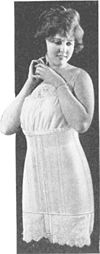
Rayon
Rayon is a manufactured regenerated cellulose fiber. Because it is produced from naturally occurring polymers, it is neither a truly synthetic fiber nor a natural fiber; it is a semi-synthetic or artificial fiber. Rayon is known by the names viscose rayon and art silk in the textile industry...
garments also became widely available in the post-war period.
In the 1920s, manufacturers shifted emphasis from durability to comfort. Union suit advertisements raved about patented new designs that reduced the number of buttons and increased accessibility. Most of these experimental designs had to do with new ways to hold closed the crotch flap common on most union suits and drawers. A new woven cotton fabric called nainsook
Nainsook
Nainsook Cotton was often used to make Bias Tape in the 50's and 60's.Nainsook is a fine, soft muslin fabric, often to used to make babies' clothing....
gained popularity in the 1920s for its durability. Retailers also began selling preshrunk undergarments.
Also in the 1920s, as hemline
Hemline
The hemline is the line formed by the lower edge of a garment, such as a skirt, dress or coat, measured from the floor.The hemline is perhaps the most variable style line in fashion, changing shape and ranging in height from hip-high to floor-length...
s of women's dresses rose, women began to wear stockings to cover the exposed legs. Women's bloomers also became much shorter. The shorter bloomers became looser and less supportive as the boyish flapper
Flapper
Flapper in the 1920s was a term applied to a "new breed" of young Western women who wore short skirts, bobbed their hair, listened to jazz, and flaunted their disdain for what was then considered acceptable behavior...
look came into fashion. By the end of the decade, they came to be known as "step-ins", very much like modern panties but with wider legs. They were worn for the increased flexibility they afforded.
As dancing became a favourite pastime of young flappers, the garter belt was invented to keep stockings from falling. The increased sexual awareness of the flapper also made underwear sexier than ever before. It was the flappers who ushered in the era of lingerie.
In 1928, Maidenform
Maidenform
Maidenform Brands is a manufacturer of women's underwear, founded in 1922 by three people: seamstress Ida Rosenthal; Enid Bissett, who owned the shop that employed her; and Ida's husband, William Rosenthal...
, a company operated by Ida Rosenthal
Ida Rosenthal
Ida Rosenthal was a Russian-born American dressmaker and businesswoman who is often credited as the inventor of the brassiere. At the age of 18, she emigrated to the United States, following her fiancé William Rosenthal, and Americanized her name to Cohen...
, a Russian immigrant, developed the brassiere and introduced modern cup sizes for bras.
1930s and 1940s

Jockey International
Jockey International, Inc. is a manufacturer, distributor and retailer of underwear, sleepwear for men, women, and children. The company is based in Kenosha, Wisconsin. Jockey is known for having invented the first men's Y-Front brief in 1934. Jockey is a recognized trademark in 120...
, sent its "Mascul-line" plane to make special deliveries of "masculine support" briefs to retailers across the US. In 1938, when Jockeys were introduced in the UK, they sold at the rate of 3,000 a week.
In this decade, companies also began selling buttonless drawers fitted with an elastic waistband. These were the first true boxer shorts, which were named for their resemblance to the shorts worn by professional fighters
Boxing
Boxing, also called pugilism, is a combat sport in which two people fight each other using their fists. Boxing is supervised by a referee over a series of between one to three minute intervals called rounds...
. Scovil Manufacturing introduced the snap fastener
Snap fastener
A snap fastener is a pair of interlocking discs commonly used in place of buttons to fasten clothing. A circular lip under one disc fits into a groove on the top of the other, holding them fast until a certain amount of force is applied...
at this time, which became a popular addition to various kinds of undergarments.
Women of the 1930s brought the corset back, now called the "girdle
Girdle
A girdle is a garment that encircles the lower torso, perhaps extending below the hips, and worn often for support. The word girdle originally meant a belt. In modern English, the term girdle is most commonly used for a form of women's foundation wear that replaced the corset in popularity...
". The garment lacked the whalebone and metal supports and usually came with a brassiere (now usually called a "bra") and attached garters.
During World War II, elastic waistbands and metal snaps gave way once again to button fasteners due to rubber and metal shortages. Undergarments were harder to find as well, since soldiers abroad had priority to obtain them. By the end of the war, Jockey and Hanes remained the industry leaders in the US, but Cluett, Peabody and Company made a name for itself when it introduced a preshrinking process called "Sanforization
Sanforization
Sanforization is a process of treatment used for cotton fabrics mainly and most textiles made from natural or chemical fibres, patented by Sanford Lockwood Cluett in 1930...
", invented by Sanford Cluett in 1933, which came to be licensed by most major manufacturers.
Meanwhile, some women adopted the corset once again, now called the "waspie
Waist cincher
A waist cincher is a belt worn around the waist to make the wearer's waist physically smaller, or to create the illusion of being smaller.-Today:...
" for the wasp
Wasp
The term wasp is typically defined as any insect of the order Hymenoptera and suborder Apocrita that is neither a bee nor an ant. Almost every pest insect species has at least one wasp species that preys upon it or parasitizes it, making wasps critically important in natural control of their...
-shaped waistline
Waistline
Waistline refers to:*the waist on a human body — the narrow point of the abdomen between the ribcage and hipsor*Waistline — the line of demarcation between the upper and lower portions of a garment, which notionally corresponds to the natural waist but may vary with fashion from just...
it gave the wearer. Many women began wearing the strapless bra as well, which gained popularity for its ability to push the breasts up and enhance cleavage
Cleavage enhancement
Cleavage enhancement encompasses a range of techniques used temporarily to improve the appearance of a person's breast cleavage or to create the illusion of breast cleavage on a person who has no such cleavage...
.
1950s and 1960s
Before the 1950s, underwear consisted of simple, white pieces of clothing which were not to be shown in public. In the 1950s, underwear came to be promoted as a fashion item in its own right, and came to be made in prints and colours. Manufacturers also experimented with rayon and newer fabrics like Dacron, nylonNylon
Nylon is a generic designation for a family of synthetic polymers known generically as polyamides, first produced on February 28, 1935, by Wallace Carothers at DuPont's research facility at the DuPont Experimental Station...
and Spandex
Spandex
Spandex or elastane is a synthetic fibre known for its exceptional elasticity. It is strong, but less durable than natural Latex, its major non-synthetic competitor. It is a polyurethane-polyurea copolymer that was co-invented in 1959 by chemists C. L. Sandquist and Joseph Shivers at DuPont's...
. By 1960, men's underwear was regularly printed in loud patterns, or with messages or images such as cartoon characters.
Women's undergarments began to emphasize the breasts instead of the waist. The decade saw the introduction of the bullet bra pointed bust, inspired by Christian Dior
Christian Dior
Christian Dior , was a French fashion designer, best known as the founder of one of the world's top fashion houses, also called Christian Dior.-Life:...
's "New Look", which featured pointed cups. The original Wonderbra
Wonderbra
The Wonderbra is a type of push-up underwire brassiere that gained worldwide prominence in the 1990s. Although the Wonderbra name was first trademarked in the U.S. in 1935, the brand was developed in Canada. Moses Nadler, founder and majority owner of the Canadian Lady Corset Company, licensed the...
and push-up bra
Brassiere designs
There are a great many brassiere designs that are suitable for a wide variety of business and social settings and suitable to wear with a variety of outer clothing. The bra's shape, coverage, functionality, fit, fashion, fabric, and colour can vary widely...
by Frederick's of Hollywood
Frederick's of Hollywood
Frederick's of Hollywood is a well-known retailer of women's lingerie in the United States, with stores in many modern shopping malls across the USA....
finally hit it big. Women's panties became more colourful and decorative, and by the mid-1960s were available in two abbreviated styles called the hip-hugger and the bikini
Bikini
The bikini is typically a women's two-piece swimsuit. One part of the attire covers the breasts and the other part covers the crotch and part of or the entire buttocks, leaving an uncovered area between the two. Merriam–Webster describes the bikini as "a woman's scanty two-piece bathing suit" or "a...
(named after the Pacific Ocean island
Bikini Atoll
Bikini Atoll is an atoll, listed as a World Heritage Site, in the Micronesian Islands of the Pacific Ocean, part of Republic of the Marshall Islands....
of that name), frequently in sheer nylon fabric.
Pantyhose
Pantyhose
Pantyhose are sheer, close-fitting legwear, covering the wearer's body from the waist to the feet. Mostly considered to be a woman's and girl's garment, pantyhose appeared in the 1960s, and they provided a convenient alternative to stockings...
, also called tights in British English, which combined panties and hose into one garment, made their first appearance in 1959, invented by Glen Raven Mills of North Carolina
North Carolina
North Carolina is a state located in the southeastern United States. The state borders South Carolina and Georgia to the south, Tennessee to the west and Virginia to the north. North Carolina contains 100 counties. Its capital is Raleigh, and its largest city is Charlotte...
. The company later introduced seamless pantyhose in 1965, spurred by the popularity of the miniskirt
Miniskirt
A miniskirt, sometimes hyphenated as mini-skirt, is a skirt with a hemline well above the knees – generally no longer than below the buttocks; and a minidress is a dress with a similar meaning...
. By the end of the decade, the girdle had fallen out of favour as women chose sexier and lighter alternatives.
1970s to the present day
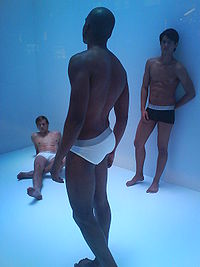
Sexual attraction
Sexual attractiveness or sex appeal refers to an individual's ability to attract the sexual or erotic interest of another person, and is a factor in sexual selection or mate choice. The attraction can be to the physical or other qualities or traits of a person, or to such qualities in the context...
became the main selling point, in swimwear as well, bringing to fruition a trend that had been building since at least the flapper era.
The tank top, an undershirt named after the type of swimwear dating from the 1920s known as a tank suit or maillot
Maillot
The maillot is the fashion designer's name for a woman's one-piece swimsuit, also called a tank suit. A maillot swimsuit generally consists of a tank-style torso top with high-cut legs...
, became popular warm-weather casual outerwear in the US in the 1980s. Performers such as Madonna
Madonna (entertainer)
Madonna is an American singer-songwriter, actress and entrepreneur. Born in Bay City, Michigan, she moved to New York City in 1977 to pursue a career in modern dance. After performing in the music groups Breakfast Club and Emmy, she released her debut album in 1983...
and Cyndi Lauper
Cyndi Lauper
Cynthia Ann Stephanie "Cyndi" Lauper is an American singer, songwriter, actress and LGBT rights activist. She achieved success in the mid-1980s with the release of the album She's So Unusual and became the first female singer to have four top-five singles released from one album...
were also often seen wearing their undergarments on top of other clothes.
Although worn for decades by exotic dancer
Exotic dancer
The terms exotic dancer and exotic dance can have different meanings in different parts of the world and depending on context. In the erotic sense, "exotic dance" is a often used to refer to practitioners of striptease...
s, in the 1980s the G-string
G-string
A G-string is a type of thong underwear or swimsuit, a narrow piece of cloth, leather, or plastic, that covers or holds the genitals, passes between the buttocks, and is attached to a band around the hips, worn as swimwear or underwear by women and men...
first gained popularity in South America, particularly in Brazil. Originally a style of swimsuit
Swimsuit
A swimsuit, bathing suit, or swimming costume is an item of clothing designed to be worn by men, women or children while they are engaging in a water-based activity or water sports, such as swimming, water polo, diving, surfing, water skiing, or during activities in the sun, such as sun bathing.A...
, the back of the garment is so narrow that it disappears between the buttocks. By the 1990s the design had made its way to most of the Western world
Western world
The Western world, also known as the West and the Occident , is a term referring to the countries of Western Europe , the countries of the Americas, as well all countries of Northern and Central Europe, Australia and New Zealand...
, and thong underwear
Thong (clothing)
The thong is a garment generally worn as either underwear or as a swimsuit in many industrialized societies around the world. It may also be worn for traditional ceremonies or competitions such as sumo wrestling...
became popular. Today, the thong is one of the fastest-selling styles of underwear among women, and is also worn by men.
While health and practicality had previously been emphasized, in the 1970s retailers of men's underpants began focusing on fashion and sex appeal. Designers such as Calvin Klein
Calvin Klein
Calvin Richard Klein is an American fashion designer who launched the company that would later become Calvin Klein Inc. in 1968. In addition to clothing, Klein has also given his name to a range of perfumes, watches, and jewelry....
began featuring near-naked models in their advertisements. The increased wealth of the gay community
Gay community
The gay community, or LGBT community, is a loosely defined grouping of LGBT and LGBT-supportive people, organizations and subcultures, united by a common culture and civil rights movements. These communities generally celebrate pride, diversity, individuality, and sexuality...
helped to promote a diversity of undergarment choices. In his book The Philosophy of Andy Warhol
The Philosophy of Andy Warhol
The Philosophy of Andy Warhol is a 1975 book by the American artist Andy Warhol . It was first published by Harcourt Brace Jovanovich....
(1975), Andy Warhol
Andy Warhol
Andrew Warhola , known as Andy Warhol, was an American painter, printmaker, and filmmaker who was a leading figure in the visual art movement known as pop art...
wrote:
Warhol liked his Jockey briefs so much that he used a pair as a canvas for one of his dollar-sign paintings.
In the UK in the 1970s, tight jeans
Jeans
Jeans are trousers made from denim. Some of the earliest American blue jeans were made by Jacob Davis, Calvin Rogers, and Levi Strauss in 1873. Starting in the 1950s, jeans, originally designed for cowboys, became popular among teenagers. Historic brands include Levi's, Lee, and Wrangler...
gave briefs a temporary edge over boxer shorts, but a decade later boxers were given a boost by Nick Kamen
Nick Kamen
Nick Kamen is an English male model, songwriter and musician, and brother of session guitarist Chester Kamen and artist Barry Kamen.-Career:...
's performance in Levi
Levi Strauss & Co.
Levi Strauss & Co. is a privately held American clothing company known worldwide for its Levi's brand of denim jeans. It was founded in 1853 when Levi Strauss came from Buttenheim, Franconia, to San Francisco, California to open a west coast branch of his brothers' New York dry goods business...
's "Launderette" TV commercial for its 501 jeans, during which he stripped down to a pair of white boxer shorts in a public laundromat
Self-service laundry
A self-service laundry is a facility where clothes are washed and dried. They are known in the United Kingdom as launderettes or laundrettes, and in the United States, Canada, and Australia as laundromats or washaterias...
.
The 1990s saw the introduction of boxer briefs
Boxer briefs
Boxer briefs are a type of men's undergarment which are long in the leg, like boxer shorts but tighter-fitting, like briefs; a hybrid between the two main types of male underwear in Australia, Canada, United Kingdom, and the United States. Depending on the manufacturer, boxer briefs may also be...
, which take the longer shape of boxers but maintain the tightness of briefs. Hip hop
Hip hop music
Hip hop music, also called hip-hop, rap music or hip-hop music, is a musical genre consisting of a stylized rhythmic music that commonly accompanies rapping, a rhythmic and rhyming speech that is chanted...
stars popularized "sagging
Sagging (fashion)
Sagging is a manner of wearing trousers below the waist, hanging below the waist area and therefore revealing much of the underwear. Sagging is predominantly a male fashion...
", in which loosely fitting jeans or shorts
Shorts
Shorts are a bifurcated garment worn by both men and women over their pelvic area, circling the waist, and covering the upper part of the legs, sometimes extending down to or even below the knee, but not covering the entire length of the leg. They are called "shorts" because they are a shortened...
were allowed to droop below the waist, exposing the waistband or a greater portion of boxer shorts, briefs, or boxer briefs worn underneath. The chiselled muscularity of Mark Wahlberg
Mark Wahlberg
Mark Robert Michael Wahlberg is an American actor, film and television producer, and former rapper. He was known as Marky Mark in his earlier years, and became famous for his 1991 debut as a musician with the band Marky Mark and the Funky Bunch. He was named No. 1 on VH1's 40 Hottest Hotties of...
(then known as Marky Mark) in a series of 1990s underwear advertisements for Calvin Klein led to his success as a white hip hop star and a Hollywood
Cinema of the United States
The cinema of the United States, also known as Hollywood, has had a profound effect on cinema across the world since the early 20th century. Its history is sometimes separated into four main periods: the silent film era, classical Hollywood cinema, New Hollywood, and the contemporary period...
actor.
The industry

The market
In January 2008 it was reported that, according to market researchMarket research
Market research is any organized effort to gather information about markets or customers. It is a very important component of business strategy...
firm Mintel
Mintel
Mintel Group Ltd is a privately owned, London-based market research firm. The corporation also maintains offices in Chicago, New York, Belfast, Shanghai, Tokyo and Sydney...
, the men's underwear market in the UK was worth £
Pound sterling
The pound sterling , commonly called the pound, is the official currency of the United Kingdom, its Crown Dependencies and the British Overseas Territories of South Georgia and the South Sandwich Islands, British Antarctic Territory and Tristan da Cunha. It is subdivided into 100 pence...
674 million, and volume sales of men's underpants rose by 24% between 2000 and 2005. British manufacturers and retailers claim that most British men prefer "trunks", or short boxer briefs. The director of menswear of major British retailer Marks & Spencer
Marks & Spencer
Marks and Spencer plc is a British retailer headquartered in the City of Westminster, London, with over 700 stores in the United Kingdom and over 300 stores spread across more than 40 countries. It specialises in the selling of clothing and luxury food products...
(M&S), which sells 40 million pairs of men's underpants a year, was quoted as saying that while boxer shorts were still the most popular at M&S, demand was easing off in favour of hipster trunks similar in design to the swimming trunks worn by actor Daniel Craig
Daniel Craig
Daniel Wroughton Craig is an English actor. His early film roles include Elizabeth, The Power of One, A Kid in King Arthur's Court and the television episodes Sharpe's Eagle, Zorro and The Young Indiana Jones Chronicles: Daredevils of the Desert...
in the James Bond
James Bond
James Bond, code name 007, is a fictional character created in 1953 by writer Ian Fleming, who featured him in twelve novels and two short story collections. There have been a six other authors who wrote authorised Bond novels or novelizations after Fleming's death in 1964: Kingsley Amis,...
film Casino Royale
Casino Royale (2006 film)
Casino Royale is the twenty-first film in the James Bond film series and the first to star Daniel Craig as fictional MI6 agent James Bond...
(2006).
Designers and retailers
A number of major designer labelDesigner label
The term designer label refers to clothing and other personal accessory items sold under an often prestigious marque which is commonly named after a designer. The term is most often only applied to luxury items...
s are renowned for their underwear collections, including Calvin Klein
Calvin Klein
Calvin Richard Klein is an American fashion designer who launched the company that would later become Calvin Klein Inc. in 1968. In addition to clothing, Klein has also given his name to a range of perfumes, watches, and jewelry....
and Dolce & Gabbana
Dolce & Gabbana
Dolce & Gabbana is an Italian luxury industry fashion house. The company was started by the Italian designers Domenico Dolce and Stefano Gabbana in Milan, Italy. By 2005 their turnover was €597 million....
. Likewise, specialist underwear brands such as 2(x)ist
2(x)ist
2ist is an American fashion label that makes men's underwear. The company was founded in 1991 and is headquartered in New York City.-History:...
, C-IN2, Ginch Gonch, Lord, Obviously and Papi
Papi Mens Underwear
James Sonzero, a Los Angeles television commercial producer, started Papi men's underwear in 1995 with about $100,000. "Papi" is Spanish slang for daddy and a term of endearment. After creating commercials for mainstream products for 13 years and watching clothing trends in clubs, Sonzero says, "I...
are constantly emerging.
Specialist retailers of underwear include high street
High Street
High Street, or the High Street, is a metonym for the generic name of the primary business street of towns or cities, especially in the United Kingdom. It is usually a focal point for shops and retailers in city centres, and is most often used in reference to retailing...
stores La Senza
La Senza
La Senza Corporation is a Canadian fashion retailer based in Dorval, Quebec, Canada, which sells lingerie and intimate apparel. The La Senza brand is currently owned by Limited Brands.- History :...
(Canada), Agent Provocateur
Agent Provocateur (lingerie)
Agent Provocateur is a British lingerie retailer founded in 1994 by Joseph Corré and Serena Rees. The first shop was opened on London's Broadwick Street in the Soho district in 1994. Since then, the company has opened 30 stores in 13 countries across the globe. In 2007, Agent Provocateur was...
(UK), Victoria's Secret
Victoria's Secret
Victoria's Secret is an American retailer of women's wear, lingerie and beauty products. It is the largest segment of publicly-traded Limited Brands with sales of over US$5 billion and an operating income of $1 billion in 2006...
(USA), and GapBody, the lingerie division of the Gap
Gap (clothing retailer)
The Gap, Inc. is an American clothing and accessories retailer based in San Francisco, California, and founded in 1969 by Donald G. Fisher and Doris F. Fisher. The company has five primary brands: the namesake Gap banner, Banana Republic, Old Navy, Piperlime and Athleta. As of September 2008,...
established in 1998 (USA). In 2008 Abercrombie & Fitch
Abercrombie & Fitch
Abercrombie & Fitch is an American retailer that focuses on casual wear for consumers aged 18 to 22. It has over 300 locations in the United States, and is expanding internationally....
opened a new chain of stores, Gilly Hicks
Gilly Hicks
Gilly Hicks is a lifestyle brand, from American company Abercrombie & Fitch, specializing in women's "knickers from casual to sexy, relaxed PJ's and beauty things." Marketed for the female consumers of its parent brand, Gilly Hicks is officially labeled as "the Cheeky cousin of Abercrombie &...
, to compete with other underwear retailers.

